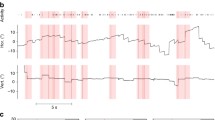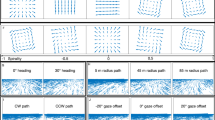Abstract
In motion-processing areas of the visual cortex in cats and monkeys, an anisotropic distribution of direction selectivities displays a preference for movements away from the fovea. This ‘centrifugal bias’ has been hypothetically linked to the processing of optic flow fields generated during forward locomotion. In this paper, we show that flow fields induced on the retina in many natural situations of locomotion of higher mammals are indeed qualitatively centrifugal in structure, even when biologically plausible eye movements to stabilize gaze on environmental targets are performed. We propose a network model of heading detection that carries an anisotropy similar to the one found in cat and monkey. In simulations, this model reproduces a number of psychophysical results of human heading detection. It suggests that a recently reported human disability to correctly identify the direction of heading from optic flow when a certain type of eye movement is simulated might be linked to the noncentrifugal structure of the resulting retinal flow field and to the neurophysiological anisotropies.
Similar content being viewed by others
References
Albright TD (1989) Centrifugal directionality bias in the middle temporal visual area (MT) of the macaque. Visual Neurosci: 177–188
Ball K, Sekuler R (1980) Human vision favors centrifugal motion. Perception 9:317–325
Bauer R, Hoffmann K-P Huber HP, Mayr M (1989) Different anisotropies of movement direction in upper and lower layers of the cat's area 18 and their implications for global optic flow processing. Exp Brain Res 74:395–401
Berg AV van den (1992) Robustness of perception of heading from optic flow. Vision Res 32:1285–1296
Berg AV van den (1993) Perception of heading. Nature 365:497–498
Brenner E, Rauschecker JP (1990) Centrifugal motion bias in the cat's lateral suprasylvian visual cortex is independent of early flow field exposure. J Physiol 423:641–660
Bülthoff H, Little J, Poggio T (1989) A parallel algorithm for real-time computation of optical flow. Nature 337:549–553
Crowell JA, Banks MS (1993) Perceiving heading with different retinal regions and types of optic flow. Percep Psychophys 53:325–337
Cutting JE, Springer K, Braren PA, Johnson SH (1992) Wayfinding on foot from information in retinal, not optical, flow. J Exp Psych Gen 121:41–72
Duffy CJ, Wurtz RH (1991) Sensitivity of MST neurons to optic flow stimuli. I. A continuum of response selectivity to large-field stimuli. J Neurophysiol 65:1329–1345
Edwards M, Badcock DR (1993) Asymmetries in the sensitivity to motion in depth: a centripetal bias. Perception 22:1013–1023
Fahle M, Wehrhahn C (1991) Motion perception in the peripheral visual field. Graefes Arch Clin Exp Ophthalmol 229:430–436
Georgeson M, Harris MG (1978) Apparent foveofugal drift of counterphase gratings. Perception 7:527–536
Gibson JJ (1950) The perception of the visual world. Houghton Mifflin, Boston
Graziano MSA, Andersen RA, Snowden R (1994) Tuning of MST neurons to spiral motions. J Neurosci 14:54–57
Hatsopoulos NG, Warren WH Jr (1991) Visual navigation with a neural network. Neural Networks 4:303–318
Heeger DJ, Jepson A (1992) Subspace methods for recovering rigid motion. I. Algorithm and implementation. IJ Comp Vision 7:95–117
Hildreth EC (1992) Recovering heading for visually-guided navigation in the presence of self-moving objects. Philos Trans R Soc Lond Biol 337:305–313
Hildreth EC (1984) The measurement of visual motion. MIT, Cambridge, Mass
Koenderink JJ, Doom AJ van (1981) Exterospecific component of the motion parallax field. J Opt Soc Am 71:953–957
Koenderink JJ, Doom AJ van (1987) Facts on optic flow. Biol Cybern 56:247–254
Lagae L, Raiguel S, Orban GA (1993) Speed and direction selectivity of macaque middle temporal neurons. J Neurophysiol 69:19–39
Lappe M, Rauschecker JP (1993a) Computation of heading direction from optic flow in visual cortex. In: Giles CL, Hanson SJ, Cowan JD (eds) Advances in neural information processing systems 5. Morgan Kaufmann, New York
Lappe M, Rauschecker JP (1993b) A neural network for the processing of optic flow from egomotion in higher mammals. Neural Comp 5:374–391
Lappe M, Rauschecker JP (1994) Heading detection from optic flow. Nature 369:712–713
Lappe M, Bremmer F, Hoffmann K-P (1994) How to use nonvisual information for optic flow processing in monkey visual cortical area MSTd. In: Marinaro M, Morasso PG (eds) ICANN 94-Proc Int Conf Artif Neur Netw Springer, Berlin Heidelberg New York
Longuet-Higgins HC, Prazdny K (1980) The interpretation of a moving retinal image. Proc R Soc Lond Biol 208:385–397
Marr D, Ullman S (1981) Directional selectivity and its use in early visual processing. Proc R Soc Lond Biol 211:151–180
Mateeff S, Yakimov N, Hohnsbein J, Ehrenstein WH, Bohdanecky Z, Radii T (1991) Selective directional sensitivity in visual motion perception. Vision Res 31:131–138
Maunsell JHR, Van Essen DC (1983) Functional properties of neurons in middle temporal visual area of the macaque monkey. I. Selectivity for stimulus direction, speed, and orientation. J Neurophysiol 49:1127–1147
Orban GA, Lagae L, Verri A, Raiguel S, Xiao D, Maes H, Torre V (1992) First-order analysis of optical flow in monkey brain. Proc Natl Acad Sci 89:2595–2599
Perrone JA (1986) Anisotropic responses to motion toward and away from the eye. Percept Psychophys 39:1–8
Perrone JA (1990) Simple technique for optical flow estimation. J Opt Soc Am [A] 7:264–278
Perrone JA (1992) Model for the computation of self-motion in biological systems. J Opt Soc Am [A] 9:177–194
Prazdny K (1980) Egomotion and relative depth map from optical flow. Biol Cybern 36:87–102
Rauschecker JP (1988) Visual function of the cat's LP/LS subsystem in global motion processing. Prog Brain Res 75:95–108
Rauschecker JP, Grünau MW von, Poulin C (1987) Centrifugal organization of direction preferences in the cat's lateral suprasylvian visual cortex and its relation to flow field processing. J Neurosci 7:943–958
Raymond JE (1994) Directional anisotropy of motion sensitivity across the visual field. Vision Res 34:1029–1037
Regan D, Beverly KI (1982) How do we avoid confounding the direction we are looking and the direction we are moving? Science 215:194–196
Reichardt W (1969) Movement perception in insects. In: Reichardt W (eds) Processing of optical data by organisms and machines. Academic Press, London, pp 465–493
Rieger JH, Toet L (1985) Human visual navigation in the presence of 3-D rotations. Biol Cybern 52:377–381
Royden CS, Banks MS, Crowell JA (1992) The perception of heading during eye movements. Nature 360:583–585
Saito H-A, Yukie M, Tanaka K, Hikosaka K, Fukada Y, Iwai E (1986) Integration of direction signals of image motion in the superior temporal sulcus of the macaque monkey. J Neurosci 6:145–157
Stoffregen TA (1985) Flow structure versus retinal location in the optical control of stance. J Exp Psychol Hum Percept Perform 11:554–565
Stoffregen TA (1986) The role of optical velocity in the control of stance. Percept Psychophys 39:355–360
Tanaka K, Saito H-A (1989) Analysis of motion of the visual field by direction, expansion/contraction, and rotation cells clustered in the dorsal part of the medial superior temporal area of the macaque monkey. J Neurophysiol 62:626–641
Tanaka K, Hikosaka K, Saito H-A, Yukie M, Fukada Y, Iwai E (1986) Analysis of local and wide-field movements in the superior temporal visual areas of the macaque monkey. J Neurosci 6:134–144
Uras A, Girosi F, Verri A, Torre V (1988) A computational approach to motion perception. Biol Cybern 60:79–87
Verri A, Aicardi F (1990) Limit cycles of the two-dimensional motion field. Biol Cybern 64:141–144
Verri A, Poggio T (1989) Motion field and optical flow: qualitative properties. IEEE Trans Patt Anal Mach Intell 11:490–498
Verri A, Girosi F, Torre V (1989) Mathematical properties of the two-dimensional motion field: from singular points to motion parameters. J Opt Soc Am [A] 6:698–712
Verri A, Straforini M, Torre V (1992) Computational aspects of motion perception in natural and artificial vision systems. Philos Trans R Soc Lond [Biol] 337:429–443
Wang HT, Mathur BP, Koch C (1989) Computing optical flow in the primate visual system. Neural Comp 1:92–103
Warren Jr WH, Hannon DJ (1988) Direction of self-motion is perceived from optical flow. Nature 336:162–163
Warren Jr WH, Hannon DJ (1990) Eye movements and optical flow. J Opt Soc Am [A] 7:160–169
Warren WH Jr, Kurtz KJ (1992) The role of central and peripheral vision in perceiving the direction of self-motion. Percept Psychophys 51:443–454
Werkhoven P, Koenderink JJ (1990) Extraction of motion parallax structure in the visual system I. Biol Cybern 63:185–191
Yuille AL, Grzywacz NM (1988) A computational theory for the perception of coherent visual motion. Nature 335:71–74
Author information
Authors and Affiliations
Rights and permissions
About this article
Cite this article
Lappe, M., Rauschecker, J.P. Motion anisotropies and heading detection. Biol. Cybern. 72, 261–277 (1995). https://doi.org/10.1007/BF00201489
Received:
Accepted:
Issue Date:
DOI: https://doi.org/10.1007/BF00201489




